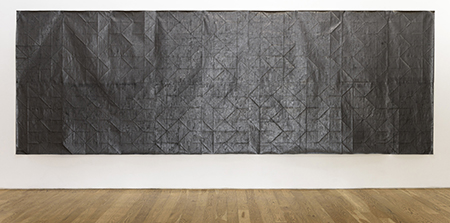
Continuing through May 6, 2017
“The built environment is both the frame and the expression of mankind.”
- Sven Sandstrom (from the exhibition’s press release)
We might ask, has exhibition curator Shannon Curie Holmes accepted the immutability of the term, ‘man made,' as a necessary conceit? Or is the fact that all seven participants are women and the two-word title, “Man Made,” serves to further emphasize the gender element intended as tongue-in-cheek, or, better yet, a slap in the face? At the top of the home page of participant Sinziana Velicescu's website, she's spelled out MAN MADE in a stern font above one of her photographs; and at the bottom right of the photo, in all lower case, it reads "an all female show." Continuing to address the exhibition's gender makeup feels a bit ridiculous because of what we would all, at this point, be thinking: if the dynamic was reversed, and it was an exhibition in which all seven artists were men, we would simply regard it as an all men's show. Rather than getting further into those weeds, let's point out that this is a group of solid local artists, which is one of the Center's specialties.
As for collectively addressing 'urban ecology,' as the show's thesis states, these types of broad-themed group shows are less about exploring an issue or phenomena than about providing a venue and platform for an array of artists. To the extent the artworks come together to make a case for a premise is sometimes of less concern than how each artist comes across, perhaps in relation to how their work addresses, in this case, 'the build environment,' though just as often independent of the thesis.
Let's start with Velicescu. In a show of under-the-radar artists, her photography makes an especially strong impression. Taking bland, '60s-era architectural facades bathed in direct California sun as her muse, she's able to extract significant poetic undertones from simple architectural forms with sharp shadows. ‘Nature' in her photos may be a palm tree or an inert patch of blue sky, though it's often the shadows that breathe a hint of life into otherwise austere urban-scapes.
Anita Bunn photographs large, spot-lit trees under dark night skies. Though unremarkable at first, with closer examination and further reflection, the trees become a form of urban species more than an object of nature. Indeed, one brightly lit and densely branched specimen in Griffith Park is an extension of its animal neighbors in the nearby zoo. Elsewhere, a sidewalk tree is dwarfed by towers of wood pallets behind a metal fence. The tree is not only too big for its cut-out patch of sidewalk, it actually appears to be sinking into its modest plot. Contrary to the cliché of the weed or flower growing out of a crack in the asphalt, this tree wants out, as if to say "I'm out of here — man wins."
Chelsea Dean de- and re-constructs desert landscapes with hand-cut photographs of shotgun shacks on fields of wood veneer, using specific homesteads as a source. In her case, in an urban-meets-nature face-off, nature's won, though it's a Pyrrhic victory. Jennifer Gunlock's amorphous collages of man-made structures posing as, or turning into, trees are the most literal hybrids of the man made and the natural. It's impossible not to anthropomorphize these amalgamations — in their violent colliding, neither seems too happy with their state, each a reluctant partner.
Michelle Robinson's work also emphasizes a kind of collision between nature and man made structural incursions. The artist takes a very tactile approach to mixed media, image-based objects to allude to both the encroachment of infrastructure as well as the persistent survival of tenacious fauna in spite of that encroachment.
Jenene Nagy and Jacqueline Bell Johnson's work arrive at the man made premise through art as object, with an emphasis on 'natural' materials (what does that mean? Materials less divorced from their source than other materials, is one way you could put it). Nagy tends toward the minimal, favoring graphite grey and linen. "Palm Flag," which features a dried palm frond looped behind a two-toned, latex-and-burlap square on the wall, is the only literal reference to 'the natural.' Elsewhere, her extensive use of graphite in sculptures and wall works emphasizes a certain earthen-ness of material and materiality. Bell Johnson presents the most installation-oriented work in the show, a sweeping intersection of hanging cut and whole tree branches, with patterns of yarn anchored by scraps of wood that is hung, in turn, from them. It's a piece made (or that could have been made) specifically for this show, and it has a certain aggressive craftiness that references the handmade along with an element of Arte Povera. Its subtext is: make do with the flotsam of which we never seem to be in short supply. It advocates as much for 'man found,' if you will, as “Man Made."
